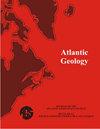Detrital zircon signatures in Precambrian and Paleozoic sedimentary units in southern New Brunswick – more pieces of the puzzle
IF 0.9
4区 地球科学
Q2 GEOLOGY
引用次数: 8
Abstract
Southern New Brunswick consists of a complex collage of fault-bounded belts of Late Neoproterozoic igneous and metamorphic rocks, Early Paleozoic sedimentary, metamorphic and igneous units, and overlying Carboniferous sedimentary rocks. The area also contains the boundary between the Avalonian and Ganderian terranes as interpreted in the northern Appalachian orogen. New detrital zircon ages reported here provide improved understanding of depositional ages and provenance of diverse Neoproterozoic to Carboniferous rocks in this complex area. Detrital zircon data from samples with Neoproterozoic maximum depositional ages indicate a dominantly Gondwanan provenance with a strong influence from the Amazonian craton. However, quartzite from The Thoroughfare Formation on Grand Manan Island contains dominanly 2 Ga zircon grains, consistent with derivation from the West African Craton. The age spectrum is similar to that from the Hutchins Island Quartzite in the Isleboro block in Penobscot Bay, Maine, strengthening the previously proposed correlation between the two areas. Cambrian samples also show prominent peri-Gondwanan provenance with strong influence from Ediacaran to Early Cambrian arc magmatism. The maximum depositional ages of these samples are consistent with previous interpretations of Cambrian ages based on fossil correlations and field data. A Carboniferous sample from Avalonia shows a significant contribution from Devonian magmatism as the youngest detrital component, although its depositional age based on field relationships is Carboniferous. The results exemplify the need to integrate multiple datasets in making interpretations from detrital zircon data.新不伦瑞克省南部前寒武纪和古生代沉积单元的碎屑锆石特征——更多谜题
新不伦瑞克省南部由新元古代晚期火成岩和变质岩、早古生代沉积岩、变质岩和火成岩单元以及上覆石炭系沉积岩的断层带组成。该区域还包含阿巴拉契亚造山带北部所解释的阿瓦隆和甘德地体之间的边界。本文报道的新碎屑锆石年龄提高了对该复杂地区新元古代至石炭系不同岩石的沉积年龄和物源的了解。来自新元古代最大沉积年龄样品的碎屑锆石数据表明,冈瓦纳大陆的主要物源受到亚马逊克拉通的强烈影响。然而,Grand Manan岛Thoroughfare组的石英岩主要含有2 Ga锆石颗粒,与西非克拉通的来源一致。年龄谱与缅因州佩诺布斯科特湾伊斯勒博罗地块的哈钦斯岛石英岩相似,加强了之前提出的两个地区之间的相关性。寒武纪样品也显示出明显的冈瓦纳大陆周围物源,受到埃迪卡拉纪至早寒武纪弧岩浆活动的强烈影响。这些样品的最大沉积年龄与之前基于化石相关性和现场数据对寒武纪年龄的解释一致。阿瓦隆尼亚的石炭纪样品显示,泥盆纪岩浆作用是最年轻的碎屑成分,尽管其沉积年代基于野外关系为石炭纪。这些结果表明,在对碎屑锆石数据进行解释时,需要整合多个数据集。
本文章由计算机程序翻译,如有差异,请以英文原文为准。
求助全文
约1分钟内获得全文
求助全文
来源期刊

Atlantic Geology
GEOLOGY-
CiteScore
2.10
自引率
18.80%
发文量
0
审稿时长
>12 weeks
期刊介绍:
Atlantic Geology (originally Maritime Sediments, subsequently Maritime Sediments and Atlantic Geology) covers all aspects of the geology of the North Atlantic region. It publishes papers, notes, and discussions on original research and review papers, where appropriate to the regional geology.
 求助内容:
求助内容: 应助结果提醒方式:
应助结果提醒方式:


